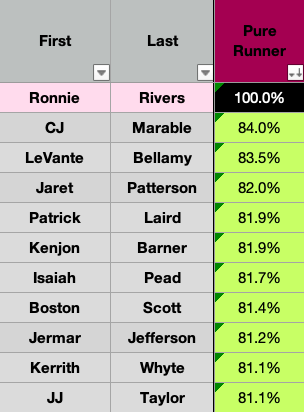Fresno State’s Ronnie Rivers is the next subject in a series in which I evaluate 2022 rookie running backs solely on their ability to run the ball. The Breakout Finder installments can be found here. The PlayerProfiler installments can be found here. If you happened to already catch those and don’t need a refresher on my methodology, feel free to skip to the player-focused analysis.
The Player
A five-year contributor at Fresno State, Ronnie Rivers is neck-and-neck with Alabama’s Brian Robinson as perhaps the most super of all the seniors in this year’s running back class. Yet, while Robinson participated in the Senior Bowl, Rivers suited up in the East-West Shrine Bowl. Doing so after reneging on his initially accepted invitation to play in the NFLPA Collegiate Bowl. This seems fitting given that he damn near was a non-traditional student that could hardly be considered a collegian. But I digress.
The Metrics
Ronnie Rivers played with a group of running back teammates collectively averaging a 1.15-star rating as high school recruits. This gives them pedigree in just the 1st-percentile among teammates of backs drafted since 2007. Relative to these less-than-stellar backfield mates, Rivers was an efficient runner. His career marks in YPC+ and Chunk Rate+ are both positive, at 0.59 and 1.08-percent, respectively. However, those figures are barely above average, respectively landing in the 54th and 52nd-percentiles.
The defensive fronts Rivers carried the ball against were 0.11 defenders lighter than those his teammates faced, on average. This is a 25th-percentile discrepancy. He did, however, outpace other Bulldog runners against every individual box count that he faced; except for on 19 total carries against 9-man boxes. Adjusting for those box counts means that the average Rivers rushing attempt was worth 119.1-percent the output of the average non-Rivers rushing attempt during his time at Fresno, a BAE Rating in the 62nd-percentile.
Some More Context
Given those raw team-relative numbers: YPC+, Chunk Rate+, and BAE Ratings in the 52nd through 62nd-percentiles, it might be logical to conclude that Ronnie Rivers is a slightly above-average prospect as a ballcarrier. Enter the importance of teammate talent-based adjustments. Rivers’ career BAE Rating mark is within two percentage points of both Cam Akers and Najee Harris. All three outperformed their teammates by approximately 20-percent per carry. Akers and Harris did so relative to teammates averaging 4.75- and 4.23-star ratings as high school recruits. Those backfields had pedigree in the 98th and 91st-percentiles, respectively. This contrasted with the 1.15 stars that Rivers’ teammates earned; an average that gives them the 5th-lowest rating among 376 total teammate groups in my database.
This isn’t all to point out that Rivers isn’t as good as Akers or Harris, because, obviously. Rather, it’s simply to illustrate the reasons why we can’t take rushing efficiency, even team-relative efficiency, at face value. Rivers was ducking under a much higher limbo bar than nearly every other player I’ve seen who ran as efficiently as he did relative to his teammates. It’s difficult to give him the benefit of the doubt because of that.
At risk of adding insult to injury, I should note that he was also bad as an open field runner. His 27.7-percent Breakaway Conversion Rate against mostly Mountain West secondaries is just a 36th-percentile mark.
Rushing Efficiency Score and Comps
According to my running back model’s composite Rushing Efficiency Score (which accounts for all the non-BAE metrics covered here, in addition to overall team quality, offensive line play, strength of opponent, and rushing volume), Ronnie Rivers earns a 44.9 out of 100. Similarly, he earns a 42.5 in a BAE-centric composite that I am currently workshopping. As suggested above, he’s just not an impressive prospect in spite of positive team-relative efficiency.
Using the same inputs as the Rushing Efficiency composite in addition to physical measurables, my running back model also generates similarity scores as a means to comp players to historical prospects. Assuming he runs a 4.50 40-yard dash at a projected 5-8, 194-pounds (based on this research), the following are his most similar players from a “pure runner” standpoint:
His overall profile is incredibly similar to C.J. Marable‘s. Like Marable and the rest of these guys, it would be a stroke of luck that results in Rivers’ ever being a regular contributor in the NFL. He’s a quality pass-catcher. But it generally takes more than that to get a legitimate opportunity given that plenty of other players are able to offer size and the ability to run the ball effectively in addition to chops as a receiver. There are several back who are able to do just that in this draft class alone.
Last Word
Ronnie Rivers had a good career in a mediocre conference. But that resumé is a dime a dozen among NFL players. He is not worth a selection in rookie drafts, and is unlikely to ever be fantasy relevant.









